Are you a Quiet Speculation member?
If not, now is a perfect time to join up! Our powerful tools, breaking-news analysis, and exclusive Discord channel will make sure you stay up to date and ahead of the curve.
Sideboarding is without a doubt one of the most essential and difficult-to-master skills in Magic: The Gathering. In tournament Magic, you play more sideboard games than pre-sideboard games by a wide margin, and the difference between sideboarding well and sideboarding poorly will frequently be a deciding factor in your eventual match result. In a format as wide and open-ended as Modern, this effect is compounded; you need to be prepared for far more decks than you would in Standard, for example. Not only that, but the depth of the card pool requires you to be prepared for a variety of lists even within a single established archetype. Does your opponent playing a RG Valakut deck have Scapeshift in their 75? Do they have Through the Breach? Chalice of the Void? Any one of these small differences can have a huge impact on your sideboarding plan.

So far, all of this is likely obvious to you; however, you also need to be aware of how the large card pool affects the construction of your own deck, a point that eludes many. What do I mean by this? Many of the archetypes within Modern are high enough in power level and consistency that sideboarding can quickly become more of a hindrance than a privilege. Sideboarding too many cards, or simply the incorrect cards, will disrupt the overarching strategy of your deck.
I would like to explore a couple different ways that sideboarding can hurt you, and how to avoid those scenarios. In Modern I've found there are two primary difficulties: one concerning quantity (sideboarding in too many cards), and one concerning quality (sideboarding in cards that are too narrow). That is certainly a little vague, so let's dive in!
Sideboarding with an "Engine" Deck
The delicate balance that sideboarding creates is more apparent when playing with particular strategies. It's a lot harder to disrupt the general flow of your own Jund deck than it is to neuter the consistency of your Krark-Clan Ironworks Combo deck.
For instance, take a look at the following list of Krark-Clan Ironworks Combo:
Krark-Clan Ironworks Combo, by Ryland Taliaferro (Test Deck)
For those of you who may be unfamiliar, Krark-Clan Ironworks (KCI) is a combo deck that utilizes the mana-making ability of KCI in combination with Modern's "Eggs"—Chromatic Sphere, Chromatic Star, and Terrarion. The goal of the deck is to abuse this synergy to draw cards at a rapid rate while generating mana, which you will use to hardcast an Emrakul, the Aeons Torn.
Putting the List to the Test
Keeping the above list in mind, imagine that you are playing against an Abzan Midrange deck. How would you sideboard? This particular list has a lot to offer that you might be interested in: Leyline of Sanctity to fight against discard; Nihil Spellbomb to weaken the power of Tarmogoyf, Lingering Souls, and Grim Flayer; Padeem, Consul of Innovation to protect your artifacts from targeted removal; and last but not least, Nature's Claim to destroy an opposing Stony Silence. All of these cards have good utility in the matchup, but at what cost?
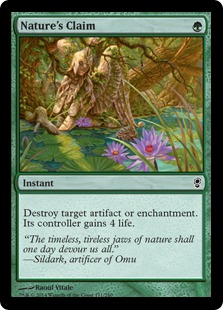 Here is how I would sideboard:
Here is how I would sideboard:
+3 Leyline of Sanctity
+4 Nature's Claim
-2 Chromatic Sphere
-3 Everflowing Chalice
-2 Terrarion
In an engine deck such as KCI combo, you can only afford to take so many crucial pieces out of the deck before the machine stops working. It is very possible to brick while comboing, and over-sideboarding will only make that more likely. Frankly, bringing in 7 cards with this strategy is already pushing it—any more would be far too detrimental to the overall consistency of the deck. Considering this, I'm unfortunately compelled to leave the Spellbombs and the Padeems at home.
When facing a situation like this one, you are forced to prioritize. You simply cannot bring in 11 cards, so which spells will make the cut? In this matchup Stony Silence is without a doubt the largest concern. It is incredibly hard to win through a Stony without answering it, so Nature's Claim is definitely coming in. In addition, the average Abzan Midrange deck will be packing around 7 discard spells between Thoughtsieze and Inquisition of Kozilek. Like any combo deck, KCI is not particularly fond of having its hand ripped to shreds. There are a few essential pieces that are generally required to win the game, and having these cards persistently discarded is not a good recipe for success. Having hexproof essentially requires your opponent to answer your threats on board rather than removing them from your hand.
Sideboarding with Hate Cards
While there is more risk of over-sideboarding with an engine deck like KCI, there are other ways of making this mistake that do not involve sheer card quantity. Sideboard cards that are too narrow can dilute your strategy in the very same way. However, this risk will certainly vary from card to card. Stony Silence is one of the most striking examples of a card that is very difficult to over-sideboard with. When you feel compelled to side in Stony, it is typically because your opponent is leaning heavily on artifacts with activated abilities that are essential to their utility. Decks like Affinity and KCI are some prominent cases. In these situations Stony is absolutely going to be worth the slot in your deck considering how disruptive it can be to your opponent's strategy.
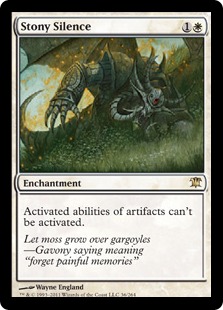 However, I would be remiss if I didn't mention that even hate cards as pointed and specific as Stony Silence do have their moments where they cross into the realm of over-sideboarding. Consider the situation when you are playing against Eldrazi and Taxes, or Merfolk. Sure, your opponent has Aether Vial, and sure, the card is outstanding in their deck. It is rare however, that it is correct to bring in Stony Silence in these cases. 90% of the time, your opponent will be quite happy to see you put a Stony Silence on the table when A) they might not even have a Vial, and B) Stony Silencedoesn't affect the current board state.
However, I would be remiss if I didn't mention that even hate cards as pointed and specific as Stony Silence do have their moments where they cross into the realm of over-sideboarding. Consider the situation when you are playing against Eldrazi and Taxes, or Merfolk. Sure, your opponent has Aether Vial, and sure, the card is outstanding in their deck. It is rare however, that it is correct to bring in Stony Silence in these cases. 90% of the time, your opponent will be quite happy to see you put a Stony Silence on the table when A) they might not even have a Vial, and B) Stony Silencedoesn't affect the current board state.
You will continue to get beat down by your opponent's rag-tag band of fish or hate bears without batting an eye. You certainly don't want to be in this situation and draw a second Stony Silence—having to see the smug look on your opponent's face as you play Stony number two the turn before you die to their pile of bears is an unpleasant circumstance to say the least. All this goes without even mentioning the fact that Vials already have diminishing returns in a game of Magic. They are largely bad top-decks and are often worse in multiples.
Extracting a Plan
Compare this to a card like Surgical Extraction. Surgical is also a card that appears in many sideboards, and rightfully so—sitting down to play some Modern without graveyard hate in your 75 is far too dangerous. There are countless decks that utilize their graveyard to execute their primary game plan: Storm, Dredge, Goryo's Vengeance...the list goes on. Whether brewing or net-decking, you will often find yourself with Surgical in your board for these reasons, and others—but when should you bring it in?
Much like Stony Silence, some of the answers seem obvious. If you find yourself seated across from Dredge or a Reanimator deck, you will quickly pull Surgical to the front when thumbing through your board—but what about a much closer case?
Imagine now that you are playing the following list of Death's Shadow Aggro and are up a game against a GW Tron opponent:
Death's Shadow Jund, by David Ochoa (3rd, Grand Prix San Antonio)
Weighing your Options
How do you board? Obviously the 2 Fulminator Mage are excellent in the matchup and should certainly come in. In addition, Maelstrom Pulse is a good way to deal with a threat that slips through the cracks, such as a Karn Liberated. But what about this singleton Surgical Extraction? If my stream's Twitch chat is any indication, many of you would bring it in. Here is what I would do:
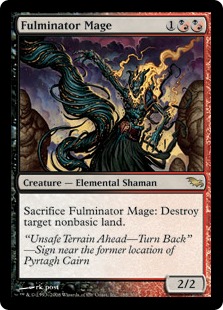 +2 Fulminator Mage
+2 Fulminator Mage
+1 Maelstrom Pulse
+1 Liliana, the Last Hope
-3 Fatal Push
-1 Terminate
This particular board doesn't really have that much for this matchup. I would prefer to have more Fulminators and likely wouldn't be opposed to some form of additional threat, or even perhaps an Ancient Grudge. That said, I would not bring in the Surgical.
Why? Certainly I understand the appeal—you constantly get to take a peek at your opponent's hand when you are playing 8 one-mana discard spells, and who doesn't want to Surgical an Urza land blown up by a previous Fulminator Mage? I don't deny that Surgical can have some power in the matchup—however, it does not ultimately assist you in your primary game plan, and will often rot in your hand with no good target. On top of that, your opponent is likely bringing in some number of Rest in Peace that could cause Surgical to be dead altogether.
Considering Your Game Plan
How would you expect the average game in this match-up to play out? Ideally, you will be leading on early discard spells and then following up with some threat, either Death's Shadow or Tarmogoyf. You will be looking to destroy your opponent's Urza lands with Fulminator Mage as quickly as possible, then hopefully repeating the process by utilizing Kolaghan's Command or Liliana the Last Hope's second ability.
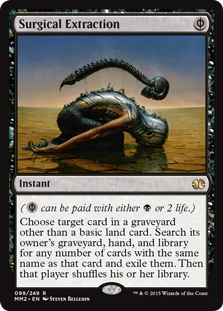 At this point in the game, if you have sided in Surgical Extraction, drawn it, and also drawn Fulminator Mage, you will find yourself with a good target: an Urza land in your opponents graveyard. Not having to worry about your opponent assembling Tron will give you some extra breathing room and help buy you plenty of time to finish the game—but was it necessary?
At this point in the game, if you have sided in Surgical Extraction, drawn it, and also drawn Fulminator Mage, you will find yourself with a good target: an Urza land in your opponents graveyard. Not having to worry about your opponent assembling Tron will give you some extra breathing room and help buy you plenty of time to finish the game—but was it necessary?
In this hypothetical situation, you have most likely already played some number of discard spells, landed a threat, and used a Fulminator Mage to destroy an opponent's Urza land. During this period, you've also been attacking with your threat(s); how much more time do you really need? You won't be able to accomplish every angle of disruption each game, but your primary game plan relies on some combination of these different angles of attack to buy you enough time for your Goyfs and Shadows to get the job done. Surgical only helps buy you additional time when drawn in combination with the Fulminator, or in combination with discard spells. Otherwise, it serves no purpose.
Everything is Situational
Consider the following alternate reality where your Death Shadow Jund list is slightly different. Your maindeck is identical to the previous list excepting the following changes:
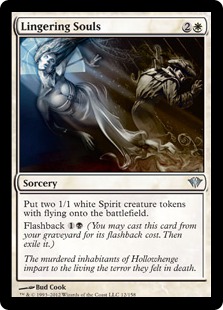 +1 Fatal Push
+1 Fatal Push
+1 Lingering Souls
-1 Abrupt Decay
-1 Terminate
Sideboard remains unchanged.
Is siding in Surgical in this instance more reasonable, or is it still over the top? Personally, this configuration would push me over the edge and cause me to side in Surgical. The Fatal Pushes cannot remain for postboard games, and the maindeck Souls (an unusual choice, to be sure) are far too slow to make a relevant impact. Nothing else in the board is particularly productive, and as such, I'm left with the Surgical. I mention this instance to illustrate how situational each sideboarding decision can be. I stand by the claim that Surgical Extraction should not be brought in for this particular matchup, when you have reasonable alternatives or don't need to cut many cards. However, sometimes you simply need to get more cards out of your maindeck—for those instances, Surgical has some merit and can definitely do the job.
Surgical Extraction is just one example of a card like this in Modern. Many "cranial" effects are similar culprits: Stain the Mind, Slaughter Games, and others. Blood Moon can often offer a comparable temptation, just as the previously mentioned Stony Silence can.
Resist the Temptation
Why as Magic players are we so often tempted to make something work even if it might be a stretch? The answer is simple: it's human nature. We often look at cards in our opening hand, cards in our sideboard, or cards available to us when constructing a deck, and we think about the ways we can make those cards work. We think about all the possible applications, the situations where they can be good, and we spend significantly less time thinking about the ways in which we can get punished for keeping a close hand or siding in a card with a very narrow application. Learning to reign in this impulse and tighten up our sideboarding decisions will ultimately lead to a higher win percentage, especially in Modern.





Having played Death’s Shadow Jund a fair bit over the last few months, I have to disagree pretty thoroughly with your analysis of the GW Tron board plan. Surgical is less a requirement than it would be in a list keeping to the 3 Fulminator/2 Surgical split that’s more common when lands decks (Tron, Valakut) are clearly at the top of the format, but nonetheless the card is important and relevant against Tron, and should always be boarded in, regardless of whether it’s used in conjunction with a Fulminator to generate a free win. The point that you’re missing is the role and matchup analysis for which you’re boarding cards in here. DS Jund is fast and consistent thanks to Traverse and it’s deck thinning enablers. Nonetheless, if given 4-5 turns, Tron will play cards DS cannot beat with any spell in it’s deck (Worldbreaker, for example) and that we can only barely outclass with a Death’s Shadow. This puts any Shadow player firmly into the aggressive role. Here, regardless of whether Surgical is paired with Fulminator, its an additional free spell that can put a Death’s Shadow on the battlefield a turn earlier. The fact that it is free is hugely important, because Shadow decks don’t lose games because they don’t draw enough cards, they lose games because they cannot deploy their cards quickly enough. Especially in a matchup where your opponent’s control plan is unbeatable given enough time, boarding in Surgical knowing that it’s an incidental free win is only going to keep someone unfamiliar with playing aggressively in a midrange oriented deck from using that extra life loss to win the turn before tron gets a body online through the discard and disruption. It’s an important option in your overall gameplan while also offering the chance at victory from another angle of play. Not boarding in the Surgical is incorrect.
Let me be clear in one regard at least; I intentionally picked a case I thought to be VERY close to create more interesting discussion, so while I disagree, I don’t think you are entirely off-base.
“…if given 4-5 turns, Tron will play cards DS cannot beat with any spell in it’s deck (Worldbreaker, for example) and that we can only barely outclass with a Death’s Shadow. Five turns is quite a few. I’m generally not planning on giving Tron that many turns, especially undisrupted. Five turns is typically going to be enough to get the job done, when they will be doing relatively little to stop you, especially through your discard. I also disagree that Worldbreaker is a card that we cannot beat as DS Jund. It can be outclassed by both Death Shadow as well as even Goyf; or removed by Terminate, Liliana of the Veil, or Maelstrom Pulse.
In addition, I think calling Surgical a “free win” when used in combination with Fulminator Mage is a bit disingenuous. In the scenario I laid out in the article you are a game up and will almost certainly be on the draw. It is not unfathomable that your opponent will be able to sneak a threat through before you are able to Fulminator, if they are able to produce Tron on turn 3. In such a case, extracting an Urza land would not be sufficient to win a game.
Like I said I think it is definitely close and situational. Thanks for reading and I appreciate you commenting to further the discussion!
Likewise! I see the points in your argument, and definitely agree that the call is a close one, and probably depends as much on the kind of game you are able to play–turn 1 take a sylvan scrying, for example–as any other factor.
First of all welcome to the site holy.
I really like the discussion presented here, though I actually disagree with the case here. The cost of playing a surgical far out weighs the costs when you take out something like tarfire which is almost stone dead in the match up. Because if you assemble the two cards its game over. That is enough for me to bring in the card.
That said oversideboarding is a real danger. Decks I really struggle with getting the balance is decks that are really synergy driven like storm, company decks etc.
Thanks Martin! I appreciate the read!
In principle I am willing to accept the premise that the cost of playing a Surgical can be overcome by the need to side out a truly awful card (hence the second example where I would bring in Surgical). However, I feel strongly that Tarfire does not fit this description. When I’m playing DSJ I don’t register Tarfire because it is outstanding in any specific matchup; I play it because it serves 3 purposes:
1) Allows me to accelerate quickly into having delirium considering it has two types that
are otherwise difficult for me to put in the yard early as well as growing Goyfs quickly.
2) Allows me to damage myself for two to cast my Shadows sooner as well as grow them.
3) Occasionally can kill an opponents creature or hit my opponent for the final couple
points of damage.
Point 3 certainly is not relevant against Tron but point 1 and 2 are especially important and I definitely want my Tarfires in as such. If killing my opponents creatures and doming my opponent was the most important factor, I would just play Bolt!
Thanks again for the welcome and I definitely appreciate your contribution to the discussion!